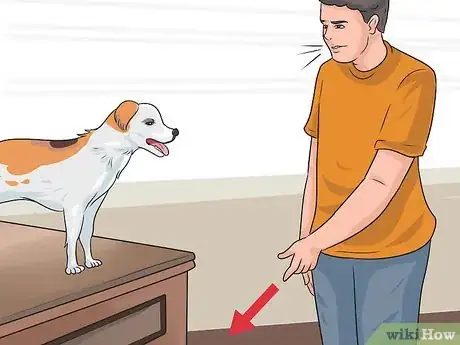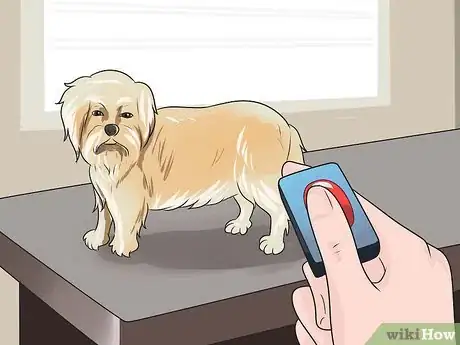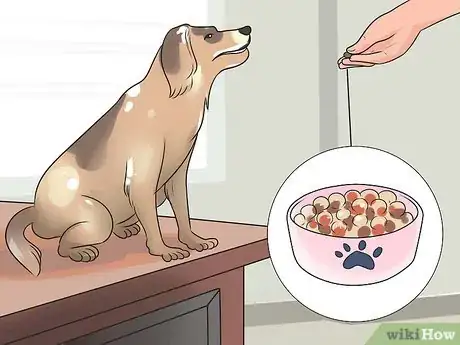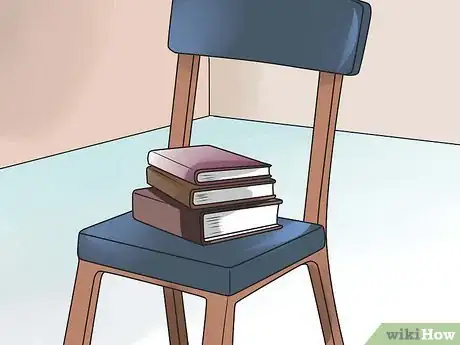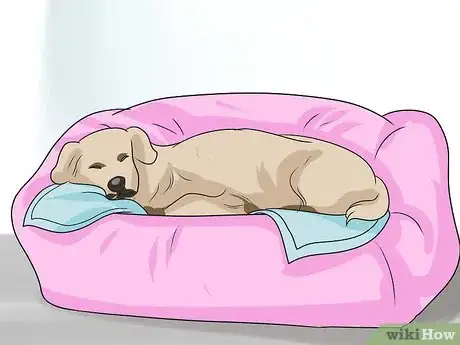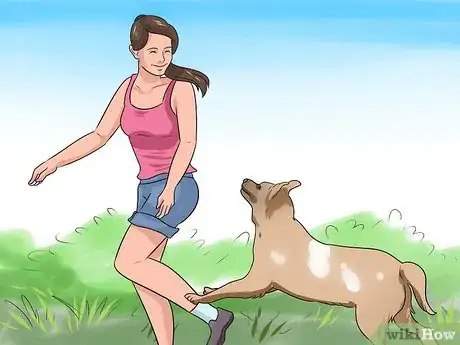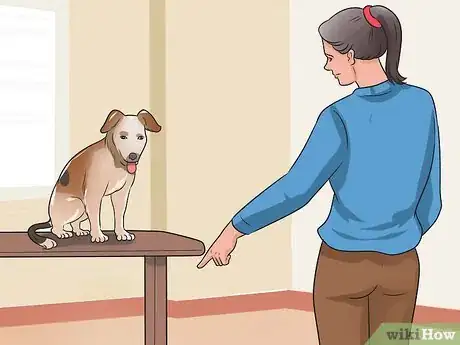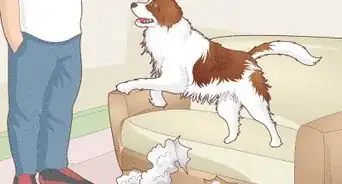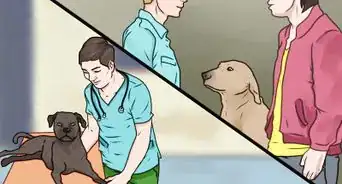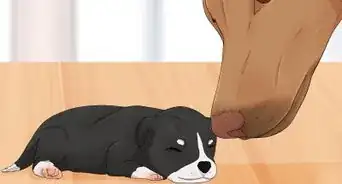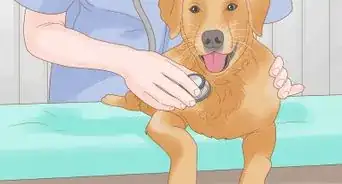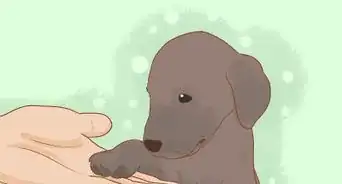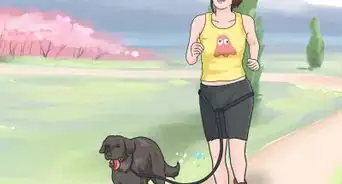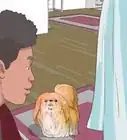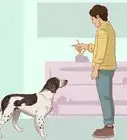This article was co-authored by Beverly Ulbrich. Beverly Ulbrich is a Dog Behaviorist and Trainer and the Founder of The Pooch Coach, a private dog training business based in the San Francisco Bay Area. She is a Certified CGC (Canine Good Citizen) Evaluator by the American Kennel Club and has served on the Board of Directors for the American Humane Association and Rocket Dog Rescue. She has been voted the best private dog trainer in the San Francisco Bay Area 4 times by SF Chronicle and by Bay Woof, and she has won 4 "Top Dog Blog" awards. She has also been featured on TV as a dog behavior expert. Beverly has over 18 years of dog behavior training experience and specializes in dog aggression and anxiety training. She has a Master of Business Administration from Santa Clara University and a BS from Rutgers University.
There are 8 references cited in this article, which can be found at the bottom of the page.
This article has been viewed 31,512 times.
Is your dog always jumping on the couch, the counter, or any surface it shouldn’t be? Dogs are just as curious as cats and oftentimes delicious treats await them if they go counter surfing. They’ll get more attention from their people if they jump up on the couch. So if your dog likes to jump up on things, it is because you haven’t taught it not to yet. In order to teach your dog to stop climbing on things in general or pieces of furniture specifically, you’ll need to condition it to avoid such places. How do you do that? You’ll need to teach it the basic “off” command and hand gesture. You’ll want to reward it for good behavior. Lastly, you need to set your dog up for success. Don’t make these surfaces so tempting.
Steps
Teaching the “Off” Command
-
1Immediately react when your dog climbs onto something. When your dog climbs up onto the counter, you need to immediately react. Dogs learn by testing their boundaries. If they have been up on these spaces for longer than a couple of seconds, they might not understand why you are telling them to get down. Rather than associating your command with their location, they might just begin to think that you’re a mean person — someone to be feared.[1]
-
2Say “off”. Say it in a firm voice. Don’t yell it, but be sure to be clear. Don’t say “off” and then several other words. You want to make sure that your dog gets the message.
- “Off” is the best word choice, if you plan to teach your dog other commands. Some people use the word “down”, but if you want to teach your dog to “lay down” this can get confusing for the dog. For example, if it gets up onto the bed and you tell it “down” it may just lay down.[2]
Advertisement -
3Use an appropriate hand gesture. Most people point to the ground when they say “off”. This gives your dog both an auditory and a visual cue that it is time to get down. It can also have the added benefit of telling your dog where it should get down at.
-
4Use a clicker. Many people will use a clicker to further reinforce proper behavior. Every time your dog gets up onto a surface it shouldn’t be on, say “off” and click the clicker while it is getting down. After a while, your dog will associate the clicking sound with the appropriate behavior (getting down). Then you can just click the clicker and the dog will get down.[3]
-
5Immediately offer your dog a treat. You should present the treat right away if you want your dog to associate their action with it. If you wait a couple of minutes after getting your dog down to give it a treat, it won’t know why it is getting it. Depending on your dog and its preferences, a “treat” might simply be a pet on the head. Typically, food rewards work best. Choose a small treat that your dog goes nuts for. There are dozens, if not hundreds, of choices for you and your dog to choose from. Make sure that the treat is not too fattening and is small enough for you to carry around.[4]
-
6Repeat the above steps until your dog understands the command. Remember to remain vigilant. You never know when a training opportunity will present itself.
Preventing Bad Behavior
-
1Put away foodstuffs. Nothing is more tempting to a dog than a pound of sliced bologna sitting on the edge of a counter. Maybe you are making a sandwich and let it there for just a few seconds while you grabbed the bread, but for your dog it was an eternity. That bologna was just too tempting so it jumped up on the counter and then got in trouble.
- Put up foods in tupperware containers. Place your bread in a designated basket away from the edge of the counter. Put cookies in the cookie jar and other pastries away in the cabinet. If your dog likes to eat fruit — as some do — move those to a designated place as well.
- If your dog has learned how to open cabinet doors, use baby-proof locks to keep them out. Eventually, your dog will learn not to even try and then you can remove the locks.[5]
-
2Block off areas where your dog isn’t allowed. Does your dog love to go sit in your favorite leather armchair? If he does and every time he jumps up on it he leaves little indentations from his nails, just block off the area. Close doors or use baby gates to block off rooms. If you do this early enough — when your dog is first introduced to a space as a puppy or whenever — your dog will soon learn what areas are off limits. Your dog will respect your boundaries, especially if he sees you as the alpha male.[6]
-
3Pile things on surfaces to block your dog. If you want your dog in the room, but not on a particular chair, simply place something on it to stop them from climbing up. Pillows don’t really work that well. They might seem like better napping materials. They are also light and can easily be dislodged. Use books, magazines, or baskets to block off these spaces. Whatever you decide to use, just make sure that it is heavy — something a light nudge of the nose won’t knock over.
-
4Make sure your dog has enough food each day. Dogs often search out food sources when they are hungry. The source of your dog’s bad behavior might be instinctual more than purely disruptive. Try feeding your dog several small meals a day, following the amount specifications for your sized dog on the back of the package. Hopefully, this will cut down on your dog’s counter surfing.[7]
- If your dog is on a diet, talk to your veterinarian about a suitable high-fiber food for your dog. He’ll be able to suggest a couple of high-protein, low fat options that will help your dog feel full.[8]
-
5Give your dog a warm place of his own. Sometimes, dogs cuddle up with their owners on the couch because they're cold or uncomfortable. Create a designated space for your canine companion. Put a blanket on a doggie bed in the corner. Give them a kennel and crate train them. This works especially well with puppies, who will come to love their separate space.
-
6Play with your dog more. Your dog might be climbing up onto things for attention, not for food. Some people enjoy sitting on the couch with their dog’s head on their laps. Others don’t. If you are in the latter group — either because you don’t want to ruin your furniture or your clothes — you should designate other time to spend with your dog. Remember it is a social creature and if you don’t make the time, it will by jump climbing up onto things to get your attention.[9]
-
7Ignore bad behavior. If your dog is jumping up for attention and you give him attention, he'll learn that this behavior is acceptable. Instead, tell him off and don't pet him. When he has returned to the floor and is calm, feel free to pet him as much as you want. He'll then associate his place on the floor with attention.[10]
-
8Be consistent. Too often dog owners will condone certain behavior some times and punish that same behavior later. Don't send mixed signals to your dog. It won't understand the intricacies of your decision making process. You need to make it cut and dry for them.[11] Don't jump on this. Climb on that. Remember that dogs love structure. Give it to them.[12]
Expert Q&A
-
QuestionHow do I teach my dog the "off" command?
 Pippa Elliott, MRCVSDr. Elliott, BVMS, MRCVS is a veterinarian with over 30 years of experience in veterinary surgery and companion animal practice. She graduated from the University of Glasgow in 1987 with a degree in veterinary medicine and surgery. She has worked at the same animal clinic in her hometown for over 20 years.
Pippa Elliott, MRCVSDr. Elliott, BVMS, MRCVS is a veterinarian with over 30 years of experience in veterinary surgery and companion animal practice. She graduated from the University of Glasgow in 1987 with a degree in veterinary medicine and surgery. She has worked at the same animal clinic in her hometown for over 20 years.
Veterinarian Training for a specific command, such as "Off," works best when you commit time to basic obedience training. Regularly spending time working on commands, such as "Sit" and "Stay," teaches the dog to listen to you more.
Training for a specific command, such as "Off," works best when you commit time to basic obedience training. Regularly spending time working on commands, such as "Sit" and "Stay," teaches the dog to listen to you more. -
QuestionHow do I teach my dog not to climb the fence?
 Beverly UlbrichBeverly Ulbrich is a Dog Behaviorist and Trainer and the Founder of The Pooch Coach, a private dog training business based in the San Francisco Bay Area. She is a Certified CGC (Canine Good Citizen) Evaluator by the American Kennel Club and has served on the Board of Directors for the American Humane Association and Rocket Dog Rescue. She has been voted the best private dog trainer in the San Francisco Bay Area 4 times by SF Chronicle and by Bay Woof, and she has won 4 "Top Dog Blog" awards. She has also been featured on TV as a dog behavior expert. Beverly has over 18 years of dog behavior training experience and specializes in dog aggression and anxiety training. She has a Master of Business Administration from Santa Clara University and a BS from Rutgers University.
Beverly UlbrichBeverly Ulbrich is a Dog Behaviorist and Trainer and the Founder of The Pooch Coach, a private dog training business based in the San Francisco Bay Area. She is a Certified CGC (Canine Good Citizen) Evaluator by the American Kennel Club and has served on the Board of Directors for the American Humane Association and Rocket Dog Rescue. She has been voted the best private dog trainer in the San Francisco Bay Area 4 times by SF Chronicle and by Bay Woof, and she has won 4 "Top Dog Blog" awards. She has also been featured on TV as a dog behavior expert. Beverly has over 18 years of dog behavior training experience and specializes in dog aggression and anxiety training. She has a Master of Business Administration from Santa Clara University and a BS from Rutgers University.
Dog Behaviorist & Trainer You likely need to put in a higher fence, and block underneath the fence if they sometimes dig out. Otherwise, it's will be almost impossible to keep the dog in the yard—eventually, something's going to happen and they're going to bolt.
You likely need to put in a higher fence, and block underneath the fence if they sometimes dig out. Otherwise, it's will be almost impossible to keep the dog in the yard—eventually, something's going to happen and they're going to bolt. -
QuestionWhat if I only want my dog on the couch sometimes?
 Beverly UlbrichBeverly Ulbrich is a Dog Behaviorist and Trainer and the Founder of The Pooch Coach, a private dog training business based in the San Francisco Bay Area. She is a Certified CGC (Canine Good Citizen) Evaluator by the American Kennel Club and has served on the Board of Directors for the American Humane Association and Rocket Dog Rescue. She has been voted the best private dog trainer in the San Francisco Bay Area 4 times by SF Chronicle and by Bay Woof, and she has won 4 "Top Dog Blog" awards. She has also been featured on TV as a dog behavior expert. Beverly has over 18 years of dog behavior training experience and specializes in dog aggression and anxiety training. She has a Master of Business Administration from Santa Clara University and a BS from Rutgers University.
Beverly UlbrichBeverly Ulbrich is a Dog Behaviorist and Trainer and the Founder of The Pooch Coach, a private dog training business based in the San Francisco Bay Area. She is a Certified CGC (Canine Good Citizen) Evaluator by the American Kennel Club and has served on the Board of Directors for the American Humane Association and Rocket Dog Rescue. She has been voted the best private dog trainer in the San Francisco Bay Area 4 times by SF Chronicle and by Bay Woof, and she has won 4 "Top Dog Blog" awards. She has also been featured on TV as a dog behavior expert. Beverly has over 18 years of dog behavior training experience and specializes in dog aggression and anxiety training. She has a Master of Business Administration from Santa Clara University and a BS from Rutgers University.
Dog Behaviorist & Trainer Get a blanket or a towel that's designated for your dog. Then, train them that when that blanket is on the furniture, it's okay for them to get up. However, don't let them go anywhere else except on that blanket. That will make it easy for your dog to understand what you're expecting.
Get a blanket or a towel that's designated for your dog. Then, train them that when that blanket is on the furniture, it's okay for them to get up. However, don't let them go anywhere else except on that blanket. That will make it easy for your dog to understand what you're expecting.
References
- ↑ https://www.aspca.org/pet-care/virtual-pet-behaviorist/dog-behavior/counter-surfing-and-garbage-raiding
- ↑ http://www.dogtrainingbasics.com/off.html
- ↑ http://www.clickertraining.com/how-to-put-an-end-to-counter-surfing
- ↑ https://www.aspca.org/pet-care/virtual-pet-behaviorist/dog-behavior/counter-surfing-and-garbage-raiding
- ↑ https://www.aspca.org/pet-care/virtual-pet-behaviorist/dog-behavior/counter-surfing-and-garbage-raiding
- ↑ https://www.aspca.org/pet-care/virtual-pet-behaviorist/dog-behavior/counter-surfing-and-garbage-raiding
- ↑ https://www.aspca.org/pet-care/virtual-pet-behaviorist/dog-behavior/counter-surfing-and-garbage-raiding
- ↑ http://www.dogfoodadvisor.com/best-dog-foods/weight-loss-dog-foods/
- ↑ www.aspca.org/pet-care/virtual-pet-behaviorist/dog-behavior/counter-surfing-and-garbage-raiding
- ↑ http://www.cesarsway.com/dog-behavior/hyper-dog/How-to-stop-puppy-from-jumping-on-people
- ↑ Beverly Ulbrich. Dog Behaviorist & Trainer. Expert Interview. 12 February 2021.
- ↑ http://www.pedigree.com/all-things-dog/article-library/training-your-puppy-to-stay-off-the-furniture.aspx
About This Article
To stop a dog from climbing up on things, immediately say “off” in a firm voice when it climbs onto things so it can associate the command with where it is and what it's doing. When saying “off,” point to the ground so it serves as a visual cue to your dog to get down. After your dog gets down, you can also immediately give it a treat, whether that’s a pat on the head or food, so it associates its behavior with the treat. For more advice from our Veterinary co-author, including how to prevent your dog from jumping onto things by giving it a comfortable place of its own, read on!


